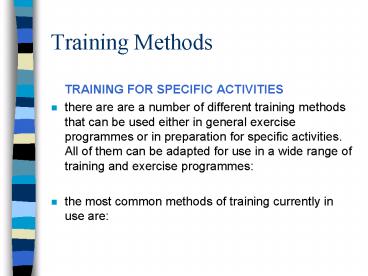Training Methods - PowerPoint PPT Presentation
1 / 11
Title:
Training Methods
Description:
there are are a number of different training methods that can be used either in ... WHOLE BODY FLEXIBILTY. ATTENTION TO EVENT-SPECIFIC JOINTS. INTERVAL TRAINING ... – PowerPoint PPT presentation
Number of Views:50
Avg rating:3.0/5.0
Title: Training Methods
1
Training Methods
- TRAINING FOR SPECIFIC ACTIVITIES
- there are are a number of different training
methods that can be used either in general
exercise programmes or in preparation for
specific activities. All of them can be adapted
for use in a wide range of training and exercise
programmes - the most common methods of training currently in
use are
2
- CIRCUIT TRAINING
- CONTINUOUS TRAINING
- FARTLEK TRAINING
- FLEXIBILITY TRAINING
- INTERVAL TRAINING
- WEIGHT TRAINING
3
- Each training method consists of exercises or
activities which may be organised into - REPETITIONS - the number of times an exercise is
repeated - SETS - The number of groups of repetitions of one
exercise
4
- CIRCUIT TRAINING - circuit training involves a
series of exercises or activities, with each one
taking place at a different station. Each station
involves an exercise aimed at a specific muscle
group in the body. - the exercises are arranged so that muscle groups
alternate between work and recovery, to allow
lactic acid dispersal and so opposing muscle
groups are worked for balanced strength
distribution
5
- CONTINUOUS TRAINING - this involves LONG, SLOW,
DISTANCE EXERCISE (LSD) at a CONSTANT RATE
WITHOUT REST. Training at first should be at 60
maximum heart rate progressing to 85 maximum
heart rate as fitness improves and the distance
involved increases to beyond competition
distance.
6
- FARTLEK TRAINING - is very similar to interval
training except that the intensity and type of
exercise are varied through changes in pace,
terrain and style. There are no fixed amounts of
each component can be planned to suit the level
of fitness of the individual - 10 min JOG 100m WALK 50m SPRINT 2m REST
- Fartlek training is effective for many sports
including running, cycling and swimming
7
- FLEXIBILITY TRAINING -
- this form of training is relevant to all sporting
activity - moving or stretching the tendons surrounding a
joint to a point marginally beyond their normal
limits is the normal way of developing and
maintaining flexibility. This can done either by
the performer or with assistance from a partner.
This is normally referred to as - ACTIVE STRETCHING
- PASSIVE STRETCHING
8
- stretching and /or flexibility exercises form
part of the training programme and a warm up
routine - flexibility should also be part of any warm up
routine prior to competition and before any
training sessions. This should also address two
aspects - WHOLE BODY FLEXIBILTY
- ATTENTION TO EVENT-SPECIFIC JOINTS
9
- INTERVAL TRAINING -
- interval training involves alternating between
fixed periods of exercise and fixed periods of
rest ( or light exercise) for recovery. Careful
planning is needed to match the duration and
intensity of exercise and recovery with the level
of fitness of the individual - 25 SPRINT 30 SEC REST 25 SPRINT 30
SEC REST - interval training is effective for most sports
teams and is appropriate method of training for
running and swimming
10
- WEIGHT TRAINING -
- weight training involves a series of exercises
where each one focuses on a specific muscle group
in the body. All of these exercises involve the
overcoming of resistance or load by the use of a
machine or free weights - repetitions and sets depend on whether the
individual is wanting to build up strength or
endurance
11
- typical programmes could be
- FOR STRENGTH FOR ENDURANCE
- 10 reps 20 reps
- 3 sets 3 sets
- large load small load
- weight training can have many effects on the body
it improves muscular strength, endurance, tone
and posture. It can increase muscular size, bone
density and metabolic rate































